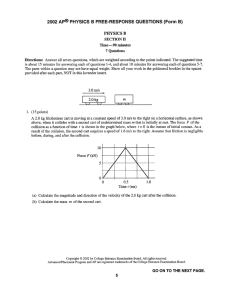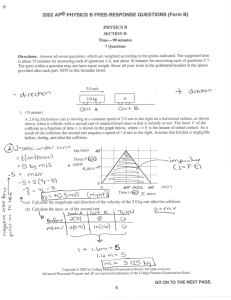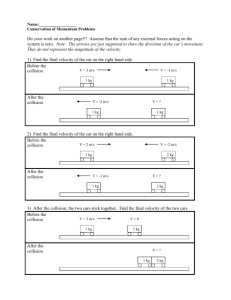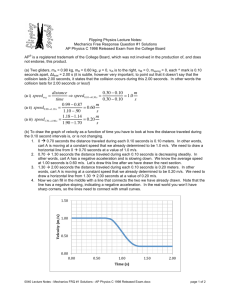AP Physics 1 released questions, course
advertisement
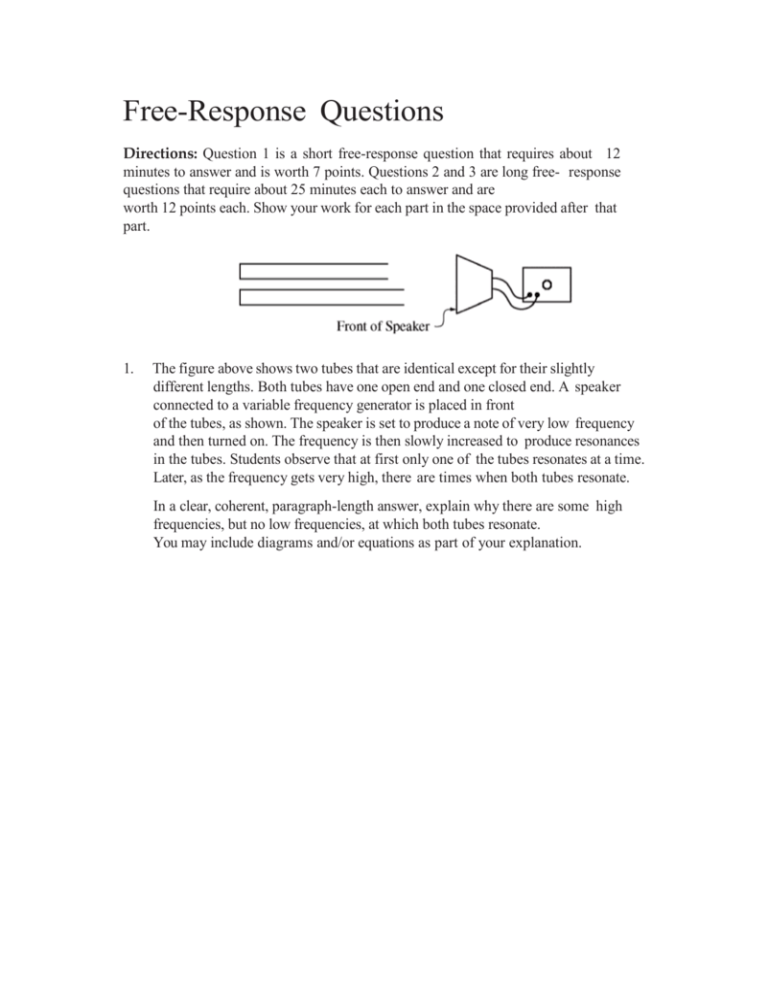
Free-Response Questions Directions: Question 1 is a short free-response question that requires about 12 minutes to answer and is worth 7 points. Questions 2 and 3 are long free- response questions that require about 25 minutes each to answer and are worth 12 points each. Show your work for each part in the space provided after that part. 1. The figure above shows two tubes that are identical except for their slightly different lengths. Both tubes have one open end and one closed end. A speaker connected to a variable frequency generator is placed in front of the tubes, as shown. The speaker is set to produce a note of very low frequency and then turned on. The frequency is then slowly increased to produce resonances in the tubes. Students observe that at first only one of the tubes resonates at a time. Later, as the frequency gets very high, there are times when both tubes resonate. In a clear, coherent, paragraph-length answer, explain why there are some high frequencies, but no low frequencies, at which both tubes resonate. You may include diagrams and/or equations as part of your explanation. 2. A group of students has two carts, A and B, with wheels that turn with negligible friction. The carts can travel along a straight horizontal track. Cart A has known mass mA. The students are asked to use a onedimensional collision between the carts to determine the mass of cart B. Before the collision, cart A travels to the right and cart B is initially at rest, as shown above. After the collision, the carts stick together. (a) Describe an experimental procedure to determine the velocities of the carts before and after a collision, including all the additional equipment you would need. You may include a labeled diagram of your setup to help in your description. Indicate what measurements you would take and how you would take them. Include enough detail so that another student could carry out your procedure. (b) There will be sources of error in the measurements taken in the experiment, both before and after the collision. For your experimental procedure, will the uncertainty in the calculated value of the mass of cart B be affected more by the error in the measurements taken before the collision or by those taken after the collision, or will it be equally affected by both sets of measurements? Justify your answer. A group of students took measurements for one collision. A graph of the students’ data is shown below. (c) Given mA = 0.50 kg, use the graph to calculate the mass of cart B. Explicitly indicate the principles used in your calculations. (d) The students are now asked to consider the kinetic energy changes in an inelastic collision, specifically whether the initial values of one of the physical quantities affect the fraction of mechanical energy dissipated in the collision. How could you modify the experiment to investigate this question? Be sure to explicitly describe the calculations you would make, specifying all equations you would use (but do not actually do any algebra or arithmetic). 3. The figure above represents a racetrack with semicircular sections connected by straight sections. Each section has length d, and markers along the track are spaced d/4 apart. Two people drive cars counterclockwise around the track, as shown. Car X goes around the curves at constant speed vc , increases speed at constant acceleration for half of each straight section to reach a maximum speed of 2vc , then brakes at constant acceleration for the other half of each straight section to return to speed vc . Car Y also goes around the curves at constant speed vc , increases speed at constant acceleration for onefourth of each straight section to reach the same maximum speed 2vc , stays at that speed for half of each straight section, then brakes at constant acceleration for the remaining fourth of each straight section to return to speed vc . (a) On the figures below, draw an arrow showing the direction of the net force on each of the cars at the positions noted by the dots. If the net force is zero at any position, label the dot with 0. (b) i. Indicate which car, if either, completes one trip around the track in less time, and justify your answer qualitatively without using equations. ii. Justify your answer about which car, if either, completes one trip around the track in less time quantitatively with appropriate equations. (c) Explain how your equations in part (b) ii re-express your reasoning in part (b) i. Do not simply refer to any final results of your calculations, but instead indicate how terms in your equations correspond to concepts in your qualitative explanation. Scoring Guidelines Scoring Guidelines for Free-Response Question 1 (7 points) Explanations can include figures to support or clarify the meaning of prose, but figures alone are not sufficient. For explaining the condition for resonance in a tube closed at one end 2 points For comparing wavelengths at low frequency to the tube lengths 1 point For linking the above two ideas (conditions of resonance and comparing wavelengths at low frequency) to explain why only one resonance occurs at a time 1 point For indicating that as frequency goes up, wavelength goes down 1 point For indicating how smaller wavelengths relate to differences in tube length, explaining how both tubes can now meet boundary conditions 2 points Example: In order to resonate, the length of a tube must be an odd multiple of a quarter wavelength of the sound, as shown below. For resonance at low frequencies, the wavelength of the sound is of the order of the length of the tubes. So the match can occur for only one tube at a time — the difference in tube lengths is much smaller than a half wavelength. As the frequency increases, the wavelength decreases and many more wavelengths fit inside a tube. When half the wavelength becomes of the order of the difference in tube lengths, the tubes can contain an odd multiple of quarter wavelengths for the same wavelength at the same time — for instance, one tube might contain 17 quarter wavelengths while the other contains 19 quarter wavelengths. Scoring Guidelines for Free-Response Question 2 (12 points) (a) (3 points) For a reasonable setup that would allow useful measurements 1 point For indicating all the measurements needed to determine the velocities 1 point For having no obviously extraneous equipment or measurements 1 point Examples: 4. Use tape to mark off two distances on the track — one for cart A before the collision and one for the combined carts after the collision. Push cart A to give it an initial speed. Use a stopwatch to measure the time it takes for the cart(s) to cross the marked distances. The speeds are the distances divided by the times. 5. Place a motion detector at the left end of the track. Push cart A to give it an initial speed. Record position as a function of time, first for cart A and then for the combined carts A and B. (b) (2 points) For indicating a reasonable assumption about the relative size of the measurement errors before and after the collision 1 point For correctly using the assumption in comparing the effect on the calculated value of the mass of cart B 1 point Example: If the measurement errors are of the same magnitude, they will have a greater effect after the collision. The speed of the combined carts will be less than the initial speed of cart A, so errors of the same magnitude will be a greater percentage of the actual value after the collision. So the values after the collision will have a greater effect on the value of the mass of cart B. A response could also argue any of the following: iii. Measurement error could be greater before the collision (it could be harder to measure with the same accuracy at the greater speed). So percent error could be the same or greater. iv. Measurement error could be greater before the collision (it could be harder to measure with the same accuracy at the greater speed). So the magnitude of the reported uncertainty could be the same. v. Measurement error could be the same before and after the collision if the same motion detector is used throughout. (c) (4 points) For providing sufficient description of the principles used in the calculation (in either a single explanation or dispersed throughout the calculations) 1 point Conservation of momentum can be used to determine the mass of cart B: mAvi = (mA + mB)vf For correctly recognizing the two regions on the graph corresponding to before and after the collision 1 point For using data from the graph to attempt calculation of speed from slope 1 point For indicating use of the slope of one or two drawn lines to determine one or more speeds (This point cannot be earned if calculations use data points not on the line[s].) 1 point The speed vi before the collision is the slope of the best-fit line for the data from 0 to 1s. The speed vf after the collision is the slope of the best-fit line for the data from 1 s to 2s. (d) (3 points) For an answer consistent with previous responses that indicates a modification of the procedure to accomplish varying the initial speed of cart A or one of the cart masses OR that indicates that the previously described procedure would provide appropriate data, so it does not need modification 1 point For indicating that the data can be used to calculate the kinetic energy K before and after the collision 1 point For indicating that the fraction of K lost in the various collisions should be compared Example: You could vary the initial speed of cart A. From the data, calculate values of kinetic energy before and after the collision using K = (1/2)mv2. Then analyze ((Ki - Kf )/Ki) to see if the changes in initial speed give different values. 1 point Scoring Guidelines for Free-Response Question 3 (12 points) (a) (3 points) Car Y For correct directions of the net forces at all the locations on the semicircular sections (i.e., all directed generally toward the center of the circle) 1 point For correct directions of the net forces at all the locations on the bottom straightaways (i.e., directed toward the center of the segment) 1 point For correct directions of the net forces at all locations on the top straightaway (i.e., both rightmost arrows directed toward the left, the left one for car X directed toward the right, and the left one for car Y equal to zero) 1 point b) (7 points total) i) (2 points) For realizing that the difference in time is only on the straightaways For correct reasoning leading to Car Y taking a shorter time on the straightaways 1 point 1 point Example: Car X takes longer to accelerate and does not spend any time traveling at top speed. Car Y accelerates over a shorter time and spends time going at top speed. So car Y must cover the straightaways in a shorter time. Curves take the same time, so car Y must overall take a shorter time. ii) (5 points) ⁄ ⁄ The time to travel each curve is d vc. Answers can be expressed in terms of d vc ⁄ or tc = d vc or some other defined unit of time. dv ⁄ For stating that the time to travel each curve is d vc 1 point For correct kinematics expressions that allow determination of the time it takes for one segment of acceleration on the straightaways 1 point t

